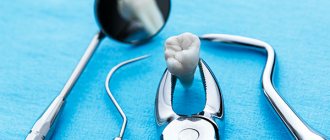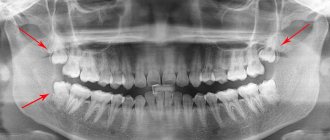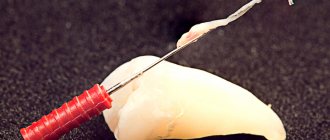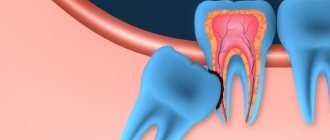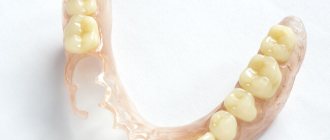We do not just a lot, but a lot of similar operations. People come from other cities, even from other countries, to get rid of annoying eights in Moscow, but we don’t understand why such a simple operation cannot be done in our city.
When asked why they needed to come to us, patients answer that they are afraid to do it anywhere else.
In one clinic they are offered to do everything at once and under anesthesia (which, to put it mildly, is very expensive and very unsafe).
In another, they almost guaranteed a nerve injury with all that it entails. Moreover, it is assumed that this should “distort the face” - pure incompetence and lies.
In the third, they demand to buy biomaterials for the holes - a waste of money and simply a dangerous procedure.
In the fourth medical institution they promised to remove the wisdom tooth in 3-4 hours, bringing this trivial operation in complexity and duration to coronary artery bypass surgery.
Why do you want to have your wisdom teeth removed with us? Because we don't do any of that!
Anesthesia.
To remove even the most difficult wisdom teeth, local anesthesia is sufficient.
Firstly, it is as safe as you can imagine and is suitable for absolutely everyone. Properly administered local anesthesia is at least several hours of persistent pain relief, sufficient to not only remove wisdom teeth, but also perform rhinoplasty and mammoplasty as a gift.
Secondly, local anesthesia has one significant advantage. In our opinion, the most important thing is maintaining verbal and non-verbal contact with the patient. Local anesthesia and preservation of all cognitive functions, at a minimum, eliminate treating the patient like a piece of meat - we feel you, worry with you and strive to cause as little discomfort as possible. A number of researchers have studied the morbidity and incidence of complications, comparing operations under local and general anesthesia, and the results of the studies were far from in favor of the latter. And there is an explanation for this. The lack of reactions on the part of the patient under sedation “frees the hands” of the surgeon; direct and feedback connections are lost between him and the patient - because of this, the traumatic nature of the operation increases sharply.
For local anesthesia when removing wisdom teeth, we use anesthetics familiar to all dentists. Mainly based on Articaine - as the most effective and safe.
Is it painful to remove a wisdom tooth?
Most people are afraid of pain during surgery, not post-operative complications. Removal is usually performed under local anesthesia, which “freezes” the tissue. It is sufficient for painless surgical treatment. Modern clinics use the drugs Ultracain or Septanest, which provide a freezing effect within a few minutes after injection into the gums.
If the patient experiences severe fear or the operation is complex and time-consuming, then general anesthesia is performed. Anesthesia completely turns off the patient’s consciousness, so he does not feel anything and does not remember about the procedure. Treatment under anesthesia is carried out in the presence of an anesthesiologist, who determines the dose and monitors the patient’s condition at the time of surgery.
Nerve damage – is it possible?
I’ll say right away that under general anesthesia it’s absolutely possible. Due to the same increasing morbidity.
The correct technology for removing wisdom teeth does not involve approaching the nerve trunk closer than 5 mm. Correctly formed access, opening and fragmentation of the tooth excludes access for cutting and sawing instruments to the apex of the wisdom tooth root, next to which the nerve usually passes. And during the removal process, you cannot make significant physical efforts, you cannot use a hammer and chisel (unfortunately, this still happens in some places). And then everything will be fine with the nerve.
Rarely, and in some patients, paresthesia still occurs after tooth extraction. It may be due to injury to the nerve trunk during anesthesia or swelling compressing the nerve in the area of surgery. After some time, sensitivity is restored. There has never been a time when she did not recover. It just takes time. Which? Alas, the process of restoring sensitivity takes different times for everyone. Some people need a couple of days, others a couple of months. But paresthesia always goes away - that's a fact.
When the probability of successful treatment is high and the doctor suggests saving the tooth
An example of an “ideal” case in which it is worth fighting for a tooth:
- The crown part of the tooth is well preserved (does not have severe destruction).
- On the x-ray, the bone tissue around the tooth is almost unchanged.
- The root canals of the tooth are free of filling material, smooth and wide.
- All teeth in the oral cavity are preserved and the diseased tooth bears normal physiological load.
- The tooth had not previously bothered me.
- The patient is practically healthy.
- The patient trusts the doctor, accepts the risks of treatment and wants to try to save the tooth.
Most likely, in this case, most doctors will undertake dental treatment, because the chances of success are high.
Why do you need to place an artificial bone in the figure eight hole?
The purpose of this procedure is one thing - to shake out more money from you, otherwise the doctor has a car loan and a mortgage. Even the most expensive biomaterials placed in the sockets of wisdom teeth do not play any useful role; their use does not carry any meaningful meaning. But it can be worse - they often fester and complicate the course of the postoperative period, leading to very sad consequences. In other words, you cannot use “artificial bone” when removing a wisdom tooth. Even if you really want to.
The most we use are collagen sponges soaked in anti-inflammatory compounds. They help stop socket bleeding and minimize inflammatory symptoms (primarily pain) immediately after removal. And they stand... they cost almost nothing.
How is complete tooth extraction performed?
When it comes to complete tooth extraction, this does not mean that all dental units are removed in one visit. It all depends on the clinical situation, namely:
- how many teeth are preserved in the oral cavity;
- how badly they are affected.
Dentists recommend removing no more than three teeth in one visit. However, in a situation where teeth affected by periodontal disease are severely loosened and their root system is exposed by more than half, it is possible to simultaneously remove all affected teeth. This is due to the fact that in this clinical situation the removal procedure is carried out very quickly and is not accompanied by severe blood loss. In this case, no stitches are even applied, just tight tampons covering the wound and hemostatic agents are enough.
If all the teeth are preserved in the oral cavity, but they are affected by periodontal disease, or if prosthetics are the indication for their removal, then the removal is carried out in 8–9 visits. In most cases, removal is performed under local anesthesia, but if there is an allergy to the components of the anesthetic, then general anesthesia is indicated. In this case, they try to remove as many teeth as possible in one procedure.
The final healing of the extracted tooth socket occurs within 3 - 4 weeks. In case of complete prosthetics, to ensure good fixation of the prosthesis, the impression can be taken only after complete healing. Otherwise, protrusions will remain on the inner surface of the prosthesis in places of unhealed wounds, and these protrusions will injure the soft tissues of the oral cavity.
When Removal is Required
Doctors recommend removal if:
- The tooth is destroyed to such an extent that filling will not solve the problem;
- With exacerbation of osteomyelitis;
- In the inflammatory process associated with infection;
- With advanced periodontitis;
- If the tooth is positioned incorrectly;
- If the jaw is damaged;
- With severe looseness;
- If a dental unit interferes with prosthetics;
- With severe caries damage.
There are rules to minimize the consequences of self-removal of a problematic tooth.
Actions after removal
It is necessary to monitor the patient's condition for several days.
Negative manifestations if:
- The wound bleeds an hour after removal;
- There is clouding of consciousness;
- The person has a fever;
- The pain has become pulsating in nature - an urgent examination by a dentist is necessary, as a jaw injury is possible.
The difference in how to pull out a molar at home or a baby tooth is only in the length of the roots. To minimize negative consequences, it is necessary to work in gloves treated with an antiseptic composition.
When the likelihood of successful treatment is low and the doctor may suggest tooth extraction
Examples of a less favorable situation:
1) The crown of the tooth is severely damaged. All that was left of the tooth was the root. This means that the tooth will have to be restored with a crown on the stump tab.
tooth restoration with a core inlay and crown
You will find more detailed information in the article What guides a dentist when he suggests restoring a tooth: with a filling, inlay, veneer or crown?
2) The x-ray shows significant destruction of bone tissue. This means that bone restoration will take longer and worse.
3) Root canals have a complex shape and removing all the infected pulp (“dental nerve”) from them is a difficult task.
4) The roots of the tooth are thin and curved. Expansion of the canals when removing infection from them can lead to the fact that the walls of the tooth cannot withstand the chewing load.
There are many difficulties in endodontic treatment; it is not for nothing that this area of dentistry is considered one of the most difficult. In the article Why you can’t give a 100% guarantee on tooth root canal treatment, we talk in detail about the difficulties of endodontic treatment, but here we will only demonstrate what a bizarre shape canals can be.
shape of the canals of the teeth of the upper and lower jaw
5) The tooth canals were previously filled. Canal retreatment is the “highest aerobatics” in endodontic treatment. It is not always possible to even unseal them. Sometimes this treatment leads to tooth extraction.
6) After unsuccessful endodontic treatment, a pin or a fragment of an instrument is fixed in the root canal. Removing foreign bodies from canals is a complex procedure with an unknown result.
7) Several teeth are missing in the oral cavity and an increased load is placed on the diseased tooth. Any depulped (“dead”) tooth copes with its function worse, since after removal of the “nerve” it becomes more fragile.
 The presence of granuloma and cyst further weakens the tooth.
The presence of granuloma and cyst further weakens the tooth.
9) The tooth periodically worries and the patient is “tired” of it.
10) The patient has concomitant diseases. And since any chronic disease weakens the immune system, the likelihood of successful treatment decreases.
The indication for tooth extraction may be one or more of the listed reasons.
Prevention of complications
The difficulty of the procedure is to avoid infection, since if microbes enter, complications will affect the entire oral cavity. To speed up wound healing, you need:
- When talking, try not to touch the hole;
- Monitor the integrity of the blood clot, which performs a protective function;
- For the first 4 hours after removal, do not eat, chew on the healthy side;
- Brush your teeth carefully and thoroughly, avoiding the socket so as not to damage the blood clot;
- Include food with plenty of liquid in the menu;
- Avoid cold and hot dishes;
- After eating, rinse your mouth with clean water or furatsilin solution to neutralize oozing blood;
- Apply warm, damp compresses to stimulate blood circulation.
Swelling may occur immediately after removal. If pain and swelling disappear within a few days, it means healing is proceeding normally.

